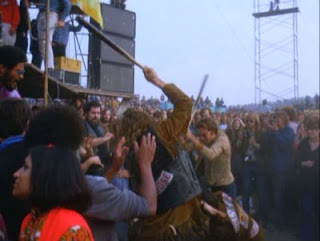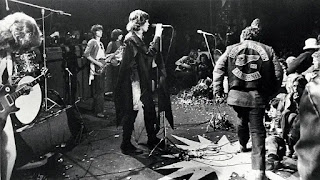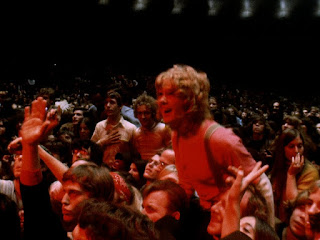SPOILER ALERT! The plot will be discussed.
Gimme Shelter (1970), from the acclaimed documentary filmmakers, the Maysles Brothers, and noted film editor Charlotte Zwerin, covers the last ten days of the Rolling Stones 1969 North American tour with the final performance at the Altamont Speedway near San Francisco on Dec. 6. Some have characterized that last concert as the demonic version of the harmony of the anti-establishment generation at the landmark festival at Woodstock, New York. There were roughly 300,000 in attendance at Altamont and the gathering was marked by conflict and eventually a killing. Whereas the youths at Woodstock happily slid around in the mud, those at Altamont would feel the need to run for cover because of the violence there. Thus, the title of the movie based on the Stones’ song takes on metaphorical meaning.
At the start of the Madison Square Garden Stones concert, the announcer asks, “Are you ready?” to the crowd. As Stanley Booth says in his essay, “The True Adventures of Altamont,” nobody was prepared for “what was to come” later at the speedway. In between footage of performances we see Mick Jagger and the other Stones members sitting with David Maysles as they watch an early print of the movie. Amy Taubin, in her piece, “Rock-and Roll Zapruder” (a reference to the footage that showed JFK assassinated), says that they look as if they are doing a “kind of postmortem.” It is an appropriate observation given the tragic event that altered what would normally be a post-production artistic act of editing. Taubin comments that the joy and exuberance reflected in Jagger’s face in New York City could indicate an overconfidence that led to the “impulsively conceived and shoddily planned” concert at Altamont. One aspect of that bad planning was to hire the Hells Angels motorcycle gang for security. The Stones had used the British version of the Angels, and that group was a much milder bunch than the violent outfit in California.
Booth notes that the Rolling Stones “worshipped
at the altar of the blues,” and that the blues “got the reputation of being the
devil’s music.” If that is the case, then the association of the Stones with
what happened at Altamont has a scary consistency. Before the Altamont concert
there were elements of conflict brewing in America as much of the population
was protesting the war in Vietnam, and there were the assassinations of Martin
Luther King, Jr. and Robert F. Kennedy in 1968. Even the Stones had lost member
Brian Jones to drowning in 1969. Altamont epitomized the love of others
fostered by the Hippie movement and the anti-establishment and reactionary hate
that existed simultaneously in the United States at that time.
The Maysles subscribe to the “cinema verité”
school of documentary filmmaking. This style tries to portray candid realism,
as opposed to Michael Moore’s approach, which uses satire, entertainment, and
some would say propaganda. But, the camera is still there, which alters the
reality to a degree, and the editing of the recording fashions the final
product to fit the filmmakers’ wishes.
The first song at Madison Square Garden is “Jumpin’Jack Flash,” and Jagger has his moves choreographed as he repeats thrusts and other gestures. There is a second where he points to something at the end of the stage and rolls his eyes, as if making a comment that an item is not quite right. He gets the lighting enhanced as he wants the members of the band to be seen. These moments show the manipulation of the proceedings to preconceived plans. Taubin says that Jagger liked to be in control of the Stones’ concerts, and the loss of that power at Altamont means he realized that he “failed to give the devil his due.” If that assessment is accurate, then it is ironic that Jagger wrote the song “Sympathy for the Devil,” and also that the tragedy at Altamont happened when he was singing, “Under My Thumb,” since the crowd was not in the singer’s grasp.
While looking over the footage, drummer Charlie
Watts observes, “it’s really hard to see this together, isn’t it?” The comment
starkly contrasts the exuberance of the early performance with the horror of
the final concert. If one didn’t know what happened at Altamont, the upsetting
facts are presented up front in a radio discussion recording, so tension is
created as the audience anticipates what they have heard happened but may not
have seen in news coverage. Sonny Barger, the Hells Angels leader, called in
and basically said they were used as dupes by Jagger to be blamed for the
violence at Altamont. He says the concertgoers were high and kicked the bikes
of the Angels, and their retaliation was justified. The Stones do not comment
much about what happened. Watts says that the way the Angels cleared a path to
the stage was startling, and says of the whole business, “Oh, dear, what a
shame.” But the lack of expressing detailed feelings allows the audience to
decide how it feels about the events and the band’s possible culpability in
what happened.
After performing “Satisfaction,” there is a clip
of a female reporter asking Jagger if, after all this time, he is satisfied. He
says sexually he is, but financially he isn’t (which is difficult to believe,
although the expenses for a big band’s operations and tours are quite high, and
“everyone wants a piece of the pie”). When it comes to being philosophically
satisfied he says he is still “trying.” His remarks have always stuck with me,
because it sounds like an honest assessment, since despite any success with
romance and finances, most of us are still “trying” to figure out what it all
really means. (However, Jagger’s comment at the screening is “rubbish,” which
stresses the artificiality of these types of promotional interviews). Booth
states that there were several free music festivals occurring and the Stones
felt the pressure to have one. Jagger announces at this press meeting that
these concerts were, “creating a sort of microcosmic society which sets an example
for the rest of America as to how one can behave in large gatherings.” Jagger
also said that the event isn’t just to listen to music, it’s an opportunity to
“talk to each other and sleep with each other, ball each other and get very
stoned, and just have a nice night out and a good day.” Ironically, Altamont
became a model for just the opposite of what he describes as a great fun-filled
social experience and shows the fallout of too much self-indulgence.
Jagger’s optimistic statement contrasts with the
next scene where famous lawyer Melvin Belli is trying to negotiate the gritty
details of staging such a music festival. Instead of “an example” of a
“microcosmic society,” there is a view expressed that these concerts are “a
pain in the ass,” since they leave destruction of property in their wake. We
then have the words, “You got to move,” sung by Jagger which in this context
stress the need to escape the situation. The soundtrack has Jagger singing
“Wild Horses,” which seems to say all is emptiness except for the love of a
woman. But those animals turn into the anarchy represented by the motorcycles
of the Angels later on.
The Maysles allow themselves some artistic leeway as they shoot Jagger in slow motion and with superimposed frames to emphasize his facial, hand, and body movements as they create a sort of bluesy ballet. Keith Richards wears a T-shirt that features Marilyn Monroe. The image is that of another pop icon, but her life ended in tragedy, and the shot is a sort of foreshadowing as to what is to come.
At another city, while singing “Honkey Tonk
Women,” a girl rushes the stage and almost knocks Jagger over. Security workers
remove other young women as they move onto or charge the stage. The heightened
sexuality of the program (inflamed earlier by Tina Turner almost having sex
with the microphone) incites audience members. The desire for individual
freedom of expression clashes with the need for social boundaries that are
there for the protection of the many. Despite what has already happened, Jagger
just adds to the lustful atmosphere by saying he broke a button on his pants
and says teasingly, “Hope they don’t fall down … You don’t want my trousers to
fall down now, do you?” The screaming of the girls answers his suggestive
question.
The fans push against boundaries of order by crowding the stage and even occupying it. They dangerously climb sound towers in a reckless attempt to get a better view of the performers. The Angels wield their pool cues which are like outlaw nightsticks. There is a plea for people to not hurt each other and a call for a doctor to treat someone. As fighting increases, lead singer Grace Slick of the Jefferson Airplane keeps calling out “Easy,” as skirmishes break out between African Americans and the Angels, adding a racial element to the hostilities. Jefferson Airplane member Paul Kantner says to the crowd that one of the Hells Angels “just smashed (singer) Marty Balin in the face and knocked him out for a bit.” In response, one of the Angels goes onstage and confronts Kantner. As other Angels wield their pool cues, Slick urges, “You gotta keep your bodies off each other unless you intend love.” Her statement shows the peaceful rebellious hippie movement slamming into the wall of hostile outsiders represented by the Angels whose idea of freedom incorporates any form of anti-establishment behavior, including violence.
The elation on the smiling faces of the audience who expected a Woodstock time now changes to grim looks of concern. Performers such as Jerry Garcia, of the Grateful Dead, hear what’s going on, including the assault on Balin, and become anxious. The Angels on their bikes part the sea of people like devilish versions of Moses as they make way for the Stones to arrive to perform. Jagger uncharacteristically has to advise the crowd to quit pushing in front of the stage and, “just keep still.” At other concerts, Jagger would fire up the audience and urge them to clap and dance, but here things are backwards, or maybe the protest age is backfiring.
Jagger starts singing “Sympathy for the Devil,” and can’t even continue with the song as a fight breaks out in front of the stage. Jagger tells the band to stop so he can try to quiet things down. He tells the crowd to “be cool,” but it’s a little late for that. He jokingly, but tellingly, says that, “Something very funny happens when we start that number.” (The band stopped playing “Sympathy for the Devil” until 1975). As the Stones continue the song, speakers on the stage that were knocked down are repositioned. The shot emphasizes how out of sorts everything is. As Jagger sings, one of the Angels on the stage looks at the singer with an angry scowl, showing his disdain for the rock star. It is a chilling, unblinking stare that prohibits enjoyment of the music. Despite the tension, some still try to sway with the sounds. The camera angle is now right down in the crowd giving us a spectator’s view of the scene as opposed to aerial shots that would lessen the feeling of turmoil.
There is a guy in the crowd who looks at Jagger, who has stopped dancing as more fighting occurs, and he just shakes his head at the singer and talks, looking as if trying to say he doesn’t understand why bad things are happening. As Jagger resumes strutting across the stage, there are more Angels looking at Jagger with contempt, showing how they are not fans of this little fellow prancing around the stage. One girl starts to cry as Jagger tells the crowd, “who’s fighting and what for?” Jagger says that if the violence doesn’t cease the band will stop playing, and he calls out to one person to quit what he is doing. Someone calls for a doctor. All of these attempts are in vain since it’s like trying to contain an explosion that has already gone off. By the time Jagger starts singing “Under My Thumb,” there is no enthusiasm left in him and he isn’t dancing. He even lets the instrumentals take over. He finishes the song by changing the words into a plea by singing, “I pray that it’s all right.”
There is another scuffle and we switch back to
Jagger looking at the footage and he asks David Maysles to rewind the tape. It
shows that an African American male who was later identified as Meredith Hunter
had a gun in his hand, and he was then stabbed to death by Hells Angels member
Alan Passaro. Because it was considered self-defense, Passaro was not
prosecuted. Jagger’s response to seeing the footage is a terse,
“horrible.”
Because what was actually happening was not clear at the time from the stage, the Stones continued to play some songs. After the concert the film shows those straggling away from the arena looking like apparitions in the dark, as if part of them died that night, too. As the screening ends, Jagger says, “All right,” as he leaves, but nothing is “right.”
The film ends with shots of the happy people
heading toward the speedway in anticipation of a great time, which contrasts
with the terrible incidents that will follow. There is irony as they smile and
the soundtrack plays “Gimme Shelter,” with Jagger singing, “Rape, murder, it’s
just a shot away, it’s just a shot away.” Life is precarious, as joy can change
to tragedy in an instant.
The next film is Cape
Fear.















No comments:
Post a Comment
Please share your thoughts about the movies discussed here.